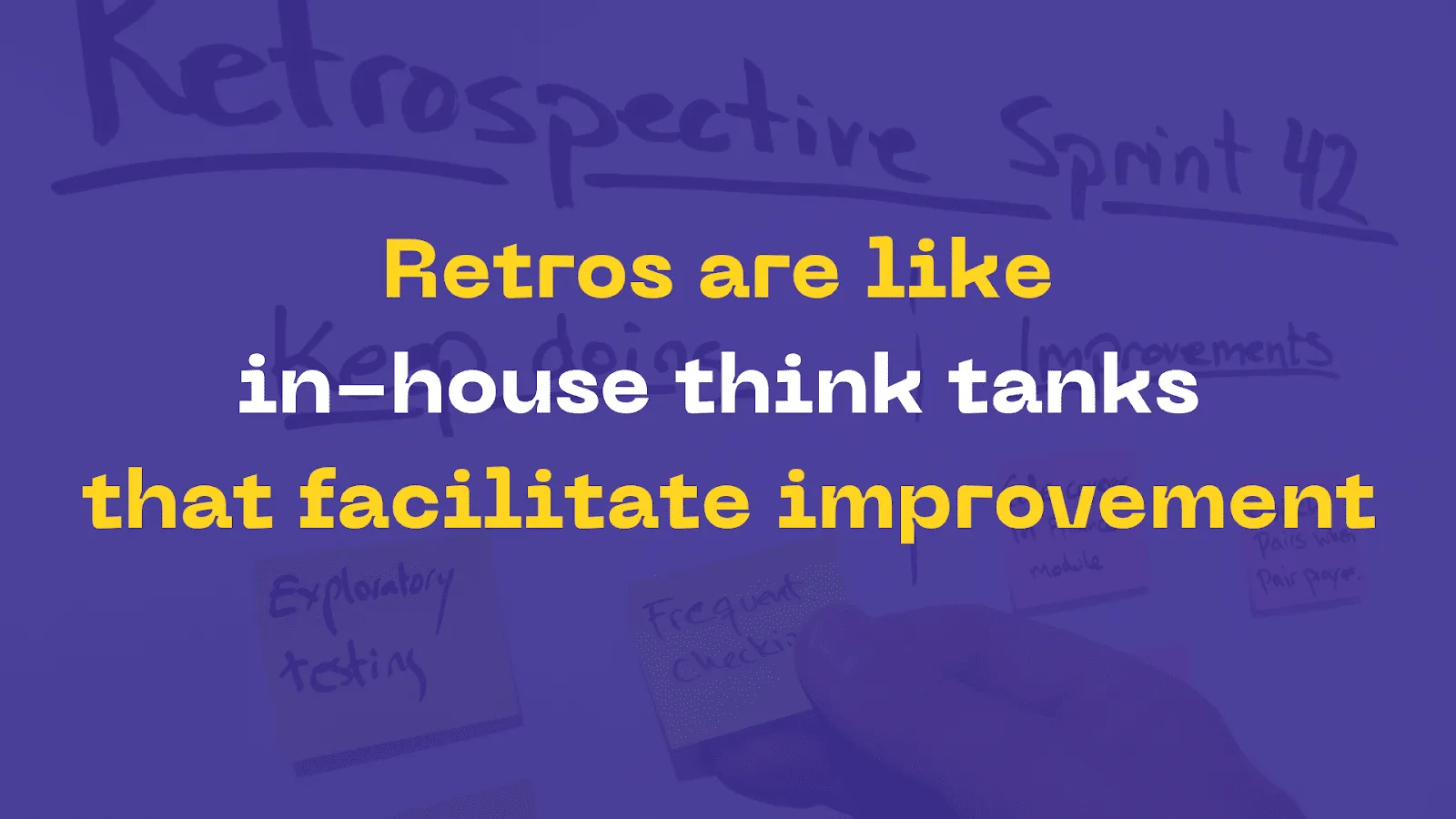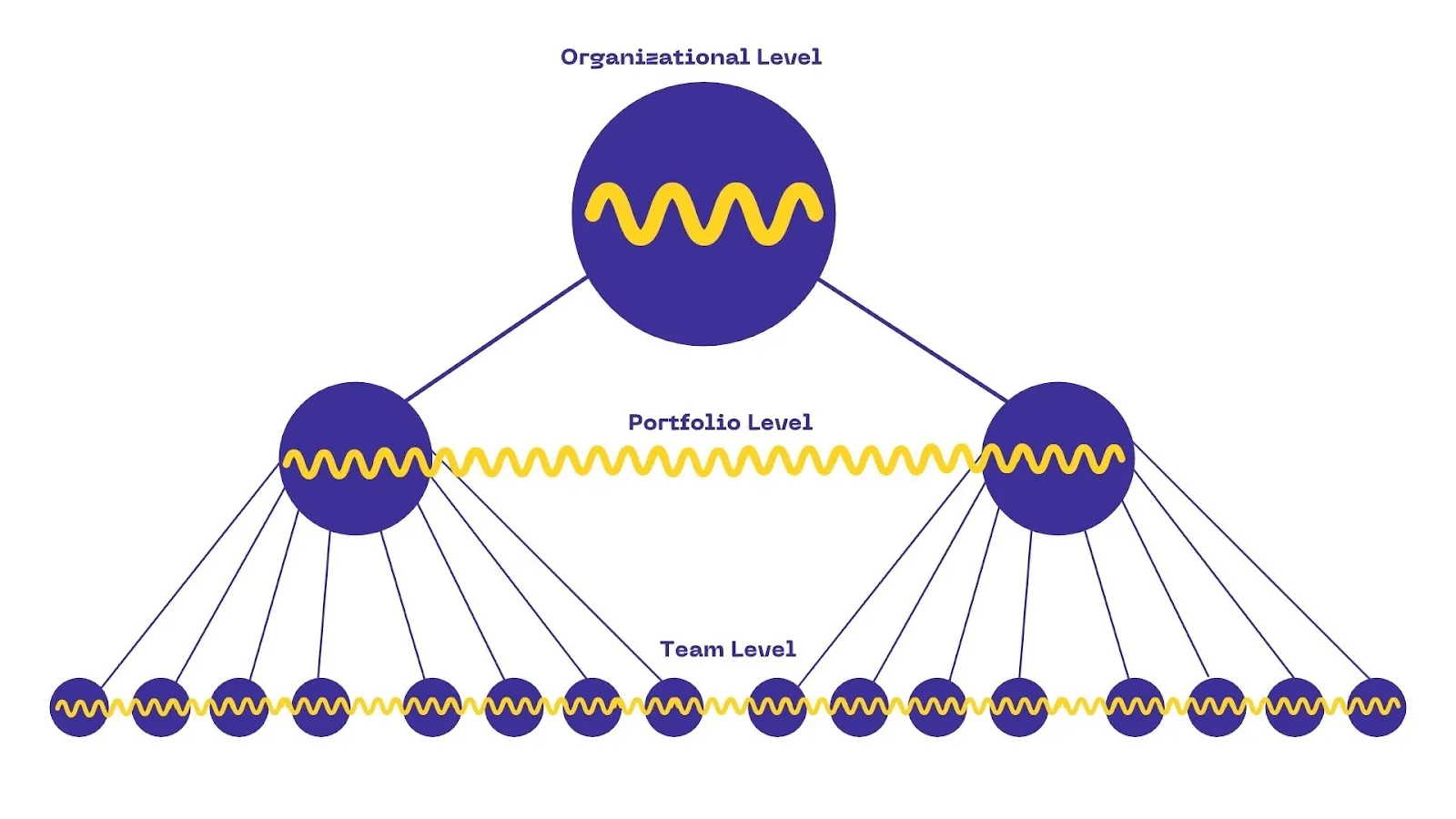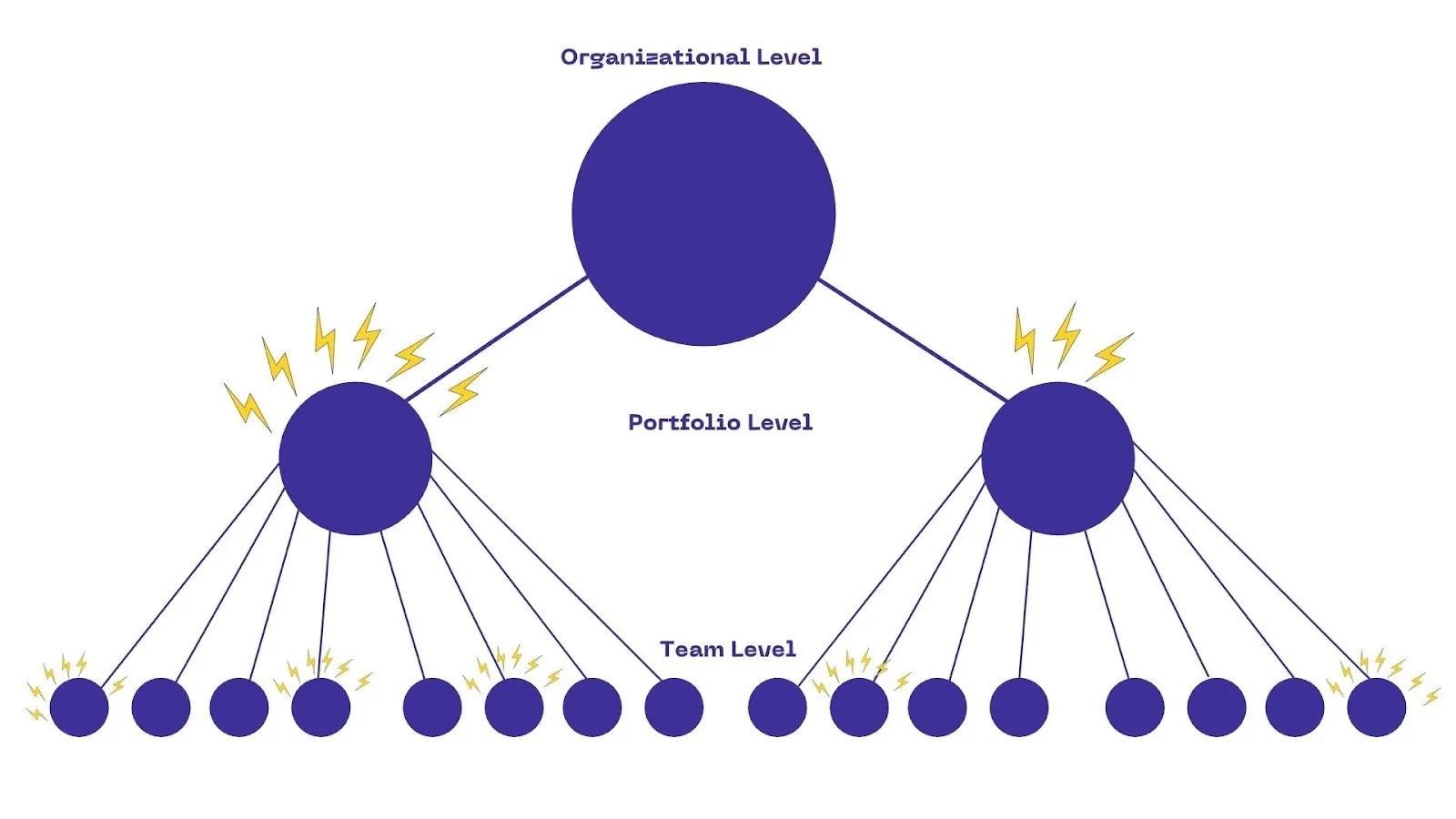
At the heart of any Agile transformation is the collective goal of eliminating organizational silos across the organization.
On the journey to a better process, teams and leaders leverage the practices of Agile ways of working to break down the barriers between functional units of the business for better communication, greater transparency and reduced handoffs.
Among the Agile practices that have done the most to optimize the connection between teams is the retrospective meeting — a moment to reflect on wins and challenges that can help or hinder organizational success.
Most Agile teams are consistent in running retros to take a step back from execution and tackle the tough questions of what’s working and what isn’t in the team’s approach. This is a great first step to tackling silos that exist among individual team members.
But, what about the silos that persist across teams, departments or throughout the various levels of our organizations as a whole?
On the planning stages, Agile offers Big Room Planning, a chance for entire departments or organizations to sync up on what’s coming down the pipeline.
To reap the full benefits of the Agile methodology and truly break down the silos that keep us from doing our best work, we need to reflect on challenges together in the same way that we plan together.
The equivalent of Big Room Planning once work is underway is the Scaled Retrospective - a way for us all to keep our finger on the pulse of the organization at all of the distinct levels of its hierarchy.
To help you scale this transformative Agile meeting, we’re deconstructing a proven framework for expanding your retros beyond just one single team.
Understanding and communicating the value of retros is the very foundation that your teams need to share before even considering to do them at scale. Retros provide regular opportunities to gather the people you work with and discuss what’s working, what’s not, and what you could improve.
However, this is just an overview of the value that retros bring. If done right, retros allow you to look at your work together and invest time to continuously find ways to improve it. You can think of them as in-house think tanks that facilitate improvement. Improvement can have many nuances like identifying ways to improve collective dynamics, practices, or processes.

Keep in mind that there are quite a few differences between a retro for a single team and a retro featuring people from more than a dozen teams.
First, you need to define the organizational levels at which you will hold your retros. Let’s look at a simple model you can apply and the topics you should cover on each retrospective level.
Team retros are the execution level of organizational retrospectives. They feature a small group of people and emphasize the behavior that the group can change to improve their performance.
The goal of a retro that features the execution team is to identify ways to get better at what you do as a unit. At this level, you should focus on the small tweaks that you can apply to get there without relying too much on dependencies to make it happen. A good way to approach team retros is by separating feedback into a couple of categories:
Many teams spend most of their retros on qualitative feedback, covering topics like workload, the pace of work, concerns around communication, dependencies, etc.

Qualitative feedback is great, but to avoid turning your retros into unproductive debates based on gut feeling, you need to add a quantitative side. At the team level, you need to put it to good use by repeatedly looking at metrics that showcase where you need to improve relying on hard data. Process metrics like sprint velocity, throughput and cycle time can be great, measurable indicators of the team productivity.
The balance between qualitative and quantitative feedback during a retro should depend on the team and the current situation. For mature teams with developed dynamics and rapport, dedicating 20-30% of the time to qualitative feedback and focusing the remaining on discussing hard data and ways to improve it is a winning strategy. On the other hand, new teams, or such that experience a lot of internal conflicts, need to focus more on the qualitative side to improve their relationships before giving more attention to process data.
A typical problem for organizations that haven’t scaled their retrospectives is local optimization with little value to the overall organizational performance. Even worse, teams become so focused on improving their work that they don’t pay attention to how this is affecting the rest of the organization.
The second level of organizational retrospectives that you can apply is program and portfolio retros. Their objective is to gather information about a collection of teams (or a collection of programs) that seeks to improve coordination of dependencies and collaborative delivery. The topics that you discuss during this expanded meeting should center around finding ways to work better together to maximize results as a unit.
Running effective retros on the program or portfolio level is considerably more difficult. In most companies, especially in enterprise-level organizations, teams tend to work in a siloed environment and have very little contact with each other. As a result, it becomes a challenge to engage people who barely know each other (if at all) and make them feel part of a cohesive unit.
The most important part of doing portfolio retros is to connect the dots between the teams. More specifically, teams should share the outputs of their retros to identify patterns and bigger issues that need to be scaled further.
This is an important step because it is a frequent occurrence for a team to get discouraged by issues outside of their control. As a result, they will likely just sweep them under the rug, focusing on what they can improve by themselves. This does little good for the overall organizational performance and creates a rift between teams due to lack of communication.
To make the most of your program or portfolio level retros, you need to hold them frequently. This is the only way that you can ensure that the data you’ve gathered during team retros (both qualitative and quantitative) is still accurate and brought up promptly during the portfolio retro.
Portfolio level retros require quite a bit more moderation because each team is likely to pull in the direction of the issues closest to them. Without identifying patterns and discussing how different teams can help each other or what needs to be escalated, the value you will get from portfolio retros will be very limited.
The organizational level is the highest one you are aiming to achieve when scaling your retrospective efforts. It features representatives of all functional departments within your organization. Organizational retros can be the most difficult to apply because of the large number of people involved and the amount of topics and data that have to be covered.
During organizational level retros, everybody needs to share information that is important to all parts of the company. This way, you’ll be able identify possible ways of improving how you work together as a whole organization.
The greatest thing about organizational retros is that they create unparalleled visibility and alignment of the issues that the company is experiencing on the execution levels. They provide you with a fantastic opportunity to drive improvement from the bottom up.
Organizational level retros facilitate collective ownership of the company’s performance. They allow people from all levels of the organization to understand their impact on the system and identify ways for improving them. Last but not least, they allow you to celebrate success as a whole and look at failures as opportunities for everyone to learn and improve.
The essence of organizational retros is to elevate issues from a local perspective to a global one. They can do miracles for breaking down silos between different functional departments (e.g. marketing, engineering, etc.) and encouraging them to work together to solve problems with global impact.
Optimizing your retros to run them at scale comes down to improving frequency and power. They are two retrospective dimensions that you need to account for and monitor closely to make your retros productive at scale.

Typically, on the team level, you would host retros after each sprint. However, due to the larger number of people involved, getting everybody’s schedules aligned to organize a retro on the upper levels becomes significantly more difficult.
As a result, companies with hundreds or even thousands of employees make the mistake of holding them too rarely. We’ve seen plenty of companies hosting portfolio retros 2-4 times a year and organizational level retros once per year.
Considering the amount of feedback that you gather in the meantime from team retros, this frequency is not nearly enough. If you want to benefit from scaling your retros, you need to hold them on a more frequent cadence.
A good starting point would be to do portfolio level retros once per month or at least once every couple of months to work with accurate data and be able to address recurring problems. On the organizational level, you should aim for at least two retros per year, or even better, once per quarter.
Although this frequency might seem like overkill for large organizations, it will allow you to spot patterns a lot more effectively and not rush into finding solutions to every little problem you hear during the higher level retros once or twice a year.

When leadership gets feedback frequently, their awareness of what’s happening in the company will become greater, which will positively impact the way they prioritize solving the problems that teams experience based on their frequency and long-term impact.

By retrospective volume, we mean the rate at which feedback is transferred across the organization. Otherwise said, volume is the power of feedback you generate during team retros and how much of it travels across the organization before resulting in actual improvements.
When optimizing your retros at scale, identify where they lose volume along the chain. The most frequent culprit for diminishing the power of retros is fear.
Many Scrum Masters, POs, and even managers higher up the chain of command are afraid of sending negative feedback upward. Therefore, it becomes unlikely to experience positive change at the lower levels. Some are afraid that leadership will consider this as a management mistake by the person reporting it. Others simply want to protect their teams from actions by the people at the top that may affect them negatively.
This makes it a real challenge to maintain a high power of feedback and to address issues across the organization.
If the volume is low, your retros will lose effectiveness because the teams will be having the same conversations over and over again without getting any result from them. This will likely lead to reduced engagement and less incoming feedback. People will feel as if they are not being heard and that there’s no point in sharing their thoughts.
To get people across the organization comfortable with sharing their thoughts, create a safe space for voicing concerns. Creating psychological safety among the team will eliminate the fear of speaking out and risking to have your career at the company impacted negatively.
If you struggle with that, initially, you can try anonymous retros. Most of the online retro tools, including ScatterSpoke, offer this functionality. Don’t hesitate to put it to good use until everybody gets comfortable with sharing their qualitative feedback publicly.
To drive home the importance of sharing feedback at all levels of the organization, incorporate reviews of retro data into planning cycles. This ensures that retro topics are revisited regularly and that the problems with the highest impact and urgency are addressed accordingly.
Last but not least, during the retros, you can opt to separate the input into feedback that needs immediate action and one that just aims to create awareness in the moment.
Doing so will make it significantly easier to keep retro volume high and evaluate the impact of each issue.
The need to work remotely throughout the past year has made retrospectives even more vital to team success than ever before. Most of us have had to adjust the way we operate and communicate with our colleagues. In turn, this brought on new challenges that retrospective meetings can help us overcome as a cohesive unit.
The model for scaling discussed in this article has been tested and proven over the years and is easily customizable to meet the needs of any organization. Whether you decide to stick with these 3 retro levels or add a few more in between, be sure to pay close attention to the frequency and volume of the feedback that they generate.
By optimizing these two crucial dimensions you are more likely to boost retrospective effectiveness and make the process of scaling your retrospective a painless one on all levels of your organization.